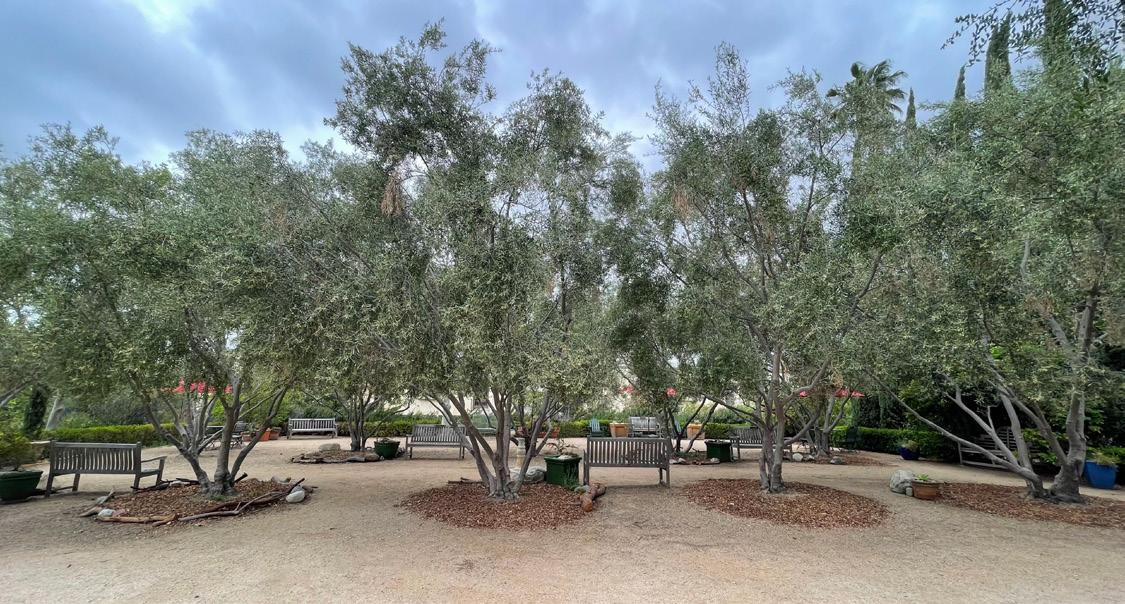
3 minute read
conebush species
A PALE FOG OF A PLANT in the sunflower family (Asteraceae), this species has fine, frond-like leaves that spill out like rolling clouds. Despite its foliage, this plant tends to fade into the background in its coastal sage scrub environment. In garden settings, it attracts more attention. Like many Artemisia species, it has an attractive, powerful scent when its leaves are crushed. Fire adapted, it is a survivor. After burning, it resprouts from its root crown around 25% of the time and produces seed. In parts of its range, California sagebrush is a habitat plant for the Coastal California Gnatcatcher, which is a federally recognized endangered species. Dusky-footed and desert woodrats also use California sagebrush as a food source.
COASTAL SAGE SCRUB, CHAPARRAL
Advertisement
California sagebrush is an iconic plant in coastal sage scrub ecosystems. Humans traveling through these ecosystems usually discover its intoxicating scent. A hiker who brushes up against sagebrush adds one note to the heady aroma; trodding on black or purple sage adds another. Beware, if you are out hiking, that the perfume doesn’t lure you into stands of poison oak!
Coast sage scrub is often called “soft chaparral.” Chaparral is the characteristic vegetation of the California
Floristic Province. If you’ve seen the hillsides of the nearby San Gabriel Mountains, then you know what it looks like, since it is the dominant type in this and many other areas around Los Angeles County.
Chaparral is composed of many woody shrubs with tightly-clustered, evergreen leaves in standardized “mediterranean” hues. The leaves are often hard and waxy. Coastal sage scrub, on the other hand, tends to have more soft-leaved species than chaparral. Its shrubs are somewhat smaller, and (unlike chaparral plants) they tend to lose their foliage over the dry summers.
CALIFORNIA SAGEBRUSH: Artemisia californica, romerillo (Spanish), powats (Tongva)
ORIGIN: California Floristic Province coastal regions from San Francisco to Baja California
MATURE HEIGHT AND WIDTH: 3-5 ft. tall and 5-7 ft. wide
GARDENING NOTES: fast growing, shallow-rooted shrub with extremely low water requirements; many cultivars are available in a variety of sizes and shapes; good selection for a habitat garden; can be kept trimmed for shape; leaves should be harvested right after new growth, following rain.
Botanical Guide
Manzanita Species
THE ANCIENT PHILOSOPHER Zeno sought to show that motion is impossible, because any movement through space can be divided into infinite sub-parts, each of which would take some amount of time to traverse. This so-called “paradox of motion” is that if you could move, you would never arrive! So, Zeno concluded, movement is an illusion. Manzanitas can look paradoxical in this way: their branches ramify and divide seemingly infinitely before arriving — through illusion — at large, smooth leaves. In reality, the species’ ramified branching is created simply by flowering: when a manzanita flowers at the tip of a branch, that branch terminates and new growth splits out behind the flower cluster. After years of repeated flowering and splitting, the mature plant becomes a cage of complex branches.

FIRE, OLD FRIEND
Most manzanita species, like the flammable whiteleaf manzanita, have shallow roots and thin bark and die even in low-intensity fires. Similar to conebushes in South Africa, manzanitas require fire to germinate, so flammability may confer an evolutionary advantage. Arctostaphylos glandulosa (Eastwood’s manzanita), on the other hand, resprouts following fire from burls, which are woody, thickened roots that protect dormant leaf buds from flames.
Drink Drupes
The name manzanita means “little apple” in Spanish, and the fruits — their scientific name is “drupes” — look like miniature manzanas (apples). The drupes of certain manzanita species are used by the Kumeyaay, the Indigenous people from around San Diego, to make a drink sweetened with sugar or honey. Soaking the fruits prior to grinding makes it easier to remove the seeds.
Bears and coyotes also consume the fruits of this genus, the origin of the name “Arctostaphylos,” which is a compound of two Greek words meaning bear (“arktos”) and grapes (“staphylos”).
Tiny Barren Kingdoms
A plant that is exclusively native to an area or growing conditions is called “endemic” to that area or conditions. San Gabriel manzanita (a subspecies of Arctostaphylos glandulosa) is a native and endemic plant in Southern California. Western sycamore, in contrast, is native but not locally endemic, since it is not restricted to Southern California.
Many manzanita species and subspecies are endemic to little zones within the mutable terrain of California: they can so dominate their tiny, infertile kingdoms that these areas are called “manzanita barrens.” Despite their hyper-local abundance, approximately 50% of manzanitas are rare or uncommon in California.










